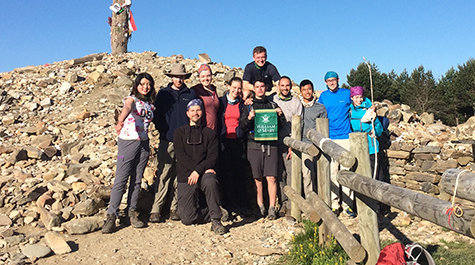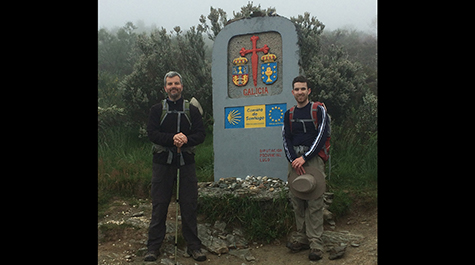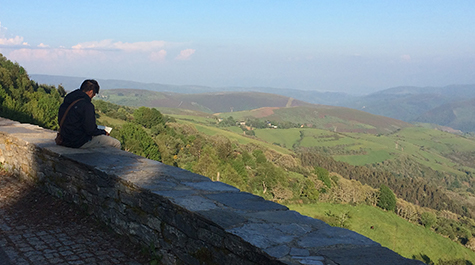A New Curriculum Transforms a Familiar Path
Camino de Santiago, Spain
Since the 9th Century A.D., countless pilgrims from all over the world have traveled the Camino de Santiago, a network of routes that terminate at the Cathedral of Santiago de Compostela in Galicia in northwestern Spain. They are men and women, children and the elderly. They travel on foot, on horseback, on bicycle or perhaps by wheelchair. They come for as many different reasons as there are pilgrims, and every one of those unique reasons results in an experience that is significant and memorable.
A group of William & Mary students and faculty traveled the Camino this past summer. It isn’t the first time W&M has sponsored a pilgrimage. But this 2016 journey was different. Not better, not less than, but different. Theirs is a tale of how the power of an idea, a bold new approach to education, becomes manifest. And so this is a tale worth telling.
The Beginning of a Plan
Our tale begins not in Spain, but in Williamsburg, in December 2013, when the Faculty of Arts & Sciences voted to approve new general education requirements for the undergraduate program.
At the time, Dean Kate Conley described the new College Curriculum (COLL) as the way to provide W&M students a common experience and a more integrated introduction to the liberal arts, to ensure “that each student leaves William & Mary able to think deeply and critically and to make new connections between various kinds of knowledge – the best kind of preparation for their future success.”
To understand fully why this new COLL was the spark for the pilgrimage, it’s helpful to learn a bit about it. The COLL experience includes:
COLL 100 & COLL 150: A first-year experience is offered in every academic discipline, laying the groundwork for a coherent liberal arts education through deep readings and group discussions of texts, data, or methods of inquiry; and exploring the concepts, beliefs and creative visions, theories, and discoveries that have shaped our understanding of the world.
COLL 200: Courses are about the academic disciplines – about where their practices intersect and diverge, the various ways they approach questions of evidence and conclusions, and how, together, they comprise the broader framework of the liberal arts. In most cases a COLL 200 course belongs to or is "anchored in" one of three knowledge domains (Arts, Letters, and Values (ALV), Cultures, Societies, and the Individual (CSI) and The Natural World and Quantitative Reasoning (NQR). Students are encouraged to make coherent and meaningful interconnections across the academic disciplines.
COLL 300: It connects students with people, places, and ideas that lift them out of familiar surroundings and deepen the way they see themselves in the world. Students are asked to use their knowledge, emerging expertise in framing questions, and communication skills to engage the world in a self-reflective, cross-cultural way.
COLL 400: The capstone experience takes place in the major, typically in senior year. Students will draw on the knowledge gained from their studies take their own scholarly initiative. They’ll be expected to synthesize and apply critical analysis, solve problems in an applied and/or academic setting, create original material or original scholarship, and communicate effectively with audiences.
Supporting this new framework, developing new curricula and working with faculty to develop new courses, is the Center for the Liberal Arts (CLA). Appointed from the faculty for two-year terms, CLA Fellows provide intellectual leadership and representation from the arts and humanities, social sciences, and natural and computational sciences, along with interdisciplinary programs. The first cohort of five Faculty Fellows began work in January 2014.
And it is within the CLA that our journey begins, as two CLA Fellows -- in the true spirit of interdisciplinary collaboration -- joined forces to craft a new experience.
Two Fellows: one Path
They are two distinguished academic professionals from two different disciplines:
Professor John “Rio” Riofrio, Associate Professor of Hispanic Studies). John Riofrio, who goes by “Rio,” received his PhD in English and is Assistant Professor of Latin Studies in the Hispanic Studies Program in the Department of Modern Languages and Literature.
Professor Matthew Allar, Class of 1955 Associate Professor of Theatre Design. Matthew Allar is resident Scenic Designer for William & Mary and specializes in Scenic Design, Lighting Design, Costume Design, Scenic Painting, Stage Properties, Creative Problem Solving, Storytelling.
Allar and Riofrio were interested in creating a program that that would fulfill the requirements of both new COLL 200 and COLL 300 as well as the current General Education credits for creative expression. Riofrio was ending his term as a CLA Fellow and Allar had just begun his, and working together, “It was a golden opportunity – on a global radical interdisciplinary level,” Allar realized.
Riofrio also understood that they would need to craft it carefully. “The challenge of the program was to create two full courses and make them both worthwhile. We designed the courses independently then met up to see where they might overlap,”
As Allar recalls, they hoped to create “an experience that any student would find accessible in the classroom and physically out in the world.” In addition, they wanted an experience “that had a beginning, middle and end that could be completed in the given time period, even if it was maybe only putting a toe in the water with these subjects.”
The appeal of the new curriculum for Allar was to find a way to broaden the reach to allow a “wider swath of faculty” of different disciplines to participate in international initiatives. It enables faculty and students both to bring their training and outlooks to bear on different fields of inquiry.
What Allar and Riofrio came up with was something entirely new – both academically and as a way to experience the Camino. They created two courses:
Theatre 460: Right Here/Right Now (Allar). Allar’s course approached the experience from visual observations and perspectives, through visual cues and site specific art.
For Allar, his role as theater designer is that of storyteller, telling a story through the visual components of theater. “The Camino is inextricably intertwined with historic storytelling, and part of what makes it interesting is what compels men and women to make the journeys – what is that primal compulsion to experience new things.”
Allar instructed the students to look for site specific art such as handmade and planned monuments, perspective and scale drawings, architecture and graffiti. He also told them to strike up impromptu conversations with travelers to ultimately create character sketches from imagined backstories.
Graffiti revealed fascinating and varied characteristics of the Camino – telling stories and providing histories of their authors, reflecting and changing with the eras of the travelers who have walked the path. Contemporary graffiti that can be seen now include things like are things gang tags and scans for directional apps. But they also saw at the Cathedral of Santiago etchings and cryptic symbols that were graffiti at the time they were made by the masons who built it. Their marks have endured to today.
HISP 389: Hike & Seek: Pilgrimage and the Global Search for Joy (Riofrio). Riofrio’s approach to the opportunities afforded by the Camino was to take a subject of importance to his students and then use the journey to explore possible answers. He has watched the effect of the amount of worry and stress in the life of students today – in his students, those he sees in class and on campus -- and it led him to think about – and ask – what are the ways people experience joy. Riofrio wanted it to be a serious exploration and to give the students the leeway to find their own questions and answers. “I originally thought I’d have the students journal,” Riofrio recalls, “But I didn’t want to have to read them because it would be intrusive.”
And Riofrio had his own questions he wanted to consider: “I asked is this relevant to students? 20-year-olds? Is this meaningful?” They would all be going on this journey. “I was there for the students, but I was also there for me.”
The Role of the Camino as Teaching Element
Nine students and our two professors embarked on their 4-week program, May 21-June 18, 2016, organized through and supported by the Reves Center Global Education Office.
Weeks 1 and 4 were in Santiago, and the two in the middle spent hiking. Each would teach his class separately for 2 weeks in Santiago, and then they would experience the walk together for 2 weeks, finishing up with a week back in Santiago. All nine students took both classes. They came from a variety of disciplines, from global performing arts and design to English and business.
The journey on the Camino provided an opportunity to explore their own ideas and also to meet a variety of individuals and engage them in their intellectual and spiritual inquiries. “On the Camino, the pilgrims are often intellectually curious by nature as shown by the fact that they’re doing it,” Allar understood. “Most are looking for something and therefore open to discussion.”
This would not be Allar’s first pilgrimage on the Camino. His first time, he was alone, and it was a chance to decompress. He found he created some wonderful friendships.
This time as Program Director, it was going to have to be a more academic approach, so Allar found himself in work mode, calling out meaningful stimuli to the students, trying to set an example. And in doing so, he had a different experience of the journey; he learned what’s possible to experience when actively engaged, and noticed visual elements and stimuli that he either hadn’t seen on his previous visit, or perhaps had too quickly looked past, not appreciating the full joy in simplicity.
Although his father had walked the Camino four years earlier, Riofrio had never thought about walking it himself, so this was going to be a new experience for him, as it was for the students.
The Lessons of the Journey: Challenges and Insights
The first week they pretty much stuck together each day from 7am to 3:30pm.
Riofrio found an unexpected challenge, which was personality: “The majority of the students saw themselves as introverts, but an integral part of the experience would be talking with people.”
It would be a challenge pedagogically as a group. The nine students looked out for one another after the first week, but then they needed to head out of the city.
However, the advantage of the Camino experience that Allar understood – which is what appealed to them in their planning for the experience -- is that introvert or not, English-speaking or not, pretty quickly you realize, “The principle goal for everyone is simply to walk to the next place, and that leads to an equal playing field, whether you’re 70 years old and from Ecuador or a 20-year old college student from Florence.”
Within a few days of walking, travelers start to see the same people, so a certain ease and camaraderie among different groups and individuals will develop.
Also, as Riofrio learned, news travels quickly. On the third day of the walk, he was doing laundry at an albergue and was stopped: “Are you the happiness professor?”
There were the kinds of serendipitous moments along the trail one often hears about, such as when they were approaching the town of Molinaseca, 32 km (or 20 miles) downhill, a very tough walk, and arrived finally to the albergue in town. It was late, and they were exhausted and without a reservation, not very hopeful they could find rooms for such a large group. And it turned out there were exactly 11 beds available.
Riofrio recounts another story with a more mundane outcome, though, where he noticed that for the first four or five days, like a magical “gift” of the Camino, at every stop there was always hand soap. It turns out it was actually that Matt Allar, as Rio recalls -- “the perfect program director” -- had thought ahead and had brought with him a supply of soap slivers to make sure there would be soap on the trip, even if the students hadn’t brought enough.
Outcomes
A pilgrim who has walked the Camino can get a “Compostela” or certificate as tangible proof. Since 2014 pilgrims have been able to certify the actual distance traveled.
As is often the case with intellectual inquiry, the end of the journey did not produce simple solutions or one right answer. However the outcomes are no less real. The students shared their stories on google maps that mark their individual journey with images and reflections (For those who would like to see the Camino through their eyes and ears, visit Brooks Henne; Martha Rose Oordt; Quinn Reiley; Alex Wingate). And because it, too, was a goal of the journey, they all earned their 6 academic credits.
As for Riofrio and Allar, their accomplishment is perhaps less tangible, yet just as long lasting. Their collaboration and willingness to devote themselves intellectually, pedagogically and physically to the new College Curriculum sets an example of the potential of creativity and boldness in a liberal arts education.
An example but not a syllabus. Because, as with the Camino, as Riofrio says: “Everyone walks their own Camino…there’s no right way or wrong way… no hierarchies… just walking.”

















